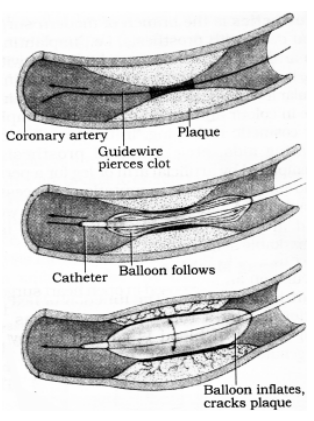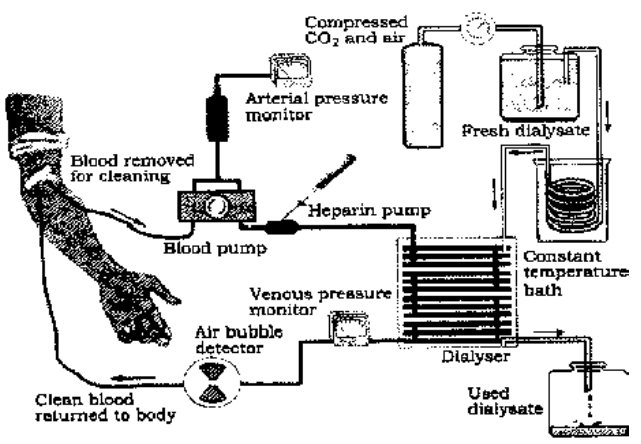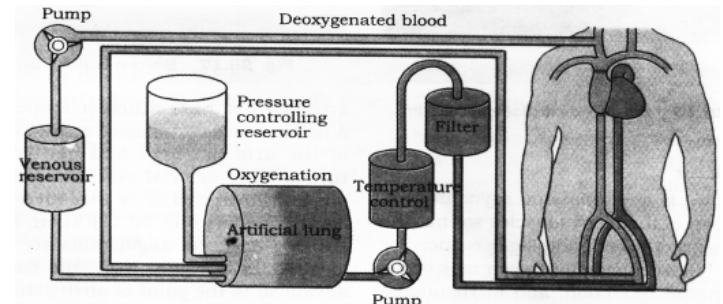
Therapeutic Instruments
Technology for Medical Applications of Class 12
Pacemakers
Artificial pacemaker is implanted when a person’s SA node does not function properly.
Introduced by Chardack (1960); supplies electrical impulses to the heart to maintain the heartbeat at a regular rate when the heart beat drops from normal of 72-80 to low levels like 30-40.
It is of two types :
Temporary and Permanent
- Temporary pacemaker : is used for few minutes to few hours to treat transient heart block and other arrhythmias; electrical current is passed by electrodes placed on the chest wall.
- Permanent pacemakers consists of a Pulse generator and an electrode.
Pulse generator is a sealed box containing lithium halide cells to provide power placed under skin below collar by surgery. Electrode consists of fine metallic wire enclosed in a thin biocompatible plastic layer, connected to pulse generator, its tip is extended to AV-node (in case of Stokes-Adam Syndrome) through pre-caval vein.
Two basic type are : fixed rate and demand type :
Fixed rate pacemakers discharge impulses at a steady rate irrespective of the hearts activity.
Demand type pacemaker discharges impulse only when the heart rate slows or a beat is missed. A normal rate of heart beat suppresses the pacemaker.
Medical Lasers (light amplification by stimulated emission of radiation) A concentrated beam of light radiation (with intense energy) is used as a light knife to cut the tissue without causing damage beyond the target area. Can be argon laser, neon laser, or carbondioxide laser. Widely used for operations on retina, like, the repair of retinal injury and removal of its tumor. Also used for sealing of bleeding arteries in peptic ulcers, destruction of abnormal cells in various parts of the body such as the cervix and treatment of endometriosis.
Laser photobleaching technique
Used to know the binding acidity of hormones with their specific receptors and the time for which hormone receptor complex remains on the plasma membrane and time taken for its internalization.
Intra-Aortic Balloon Pump
Intra-aortic balloon counter pulsation is used to improve blood supply to heart wall and other organs.
Balloon is placed in the descending aorta connected to an external pumping machine to inflate and deflate it rhythmically with helium.
Inflated during diastole it enhances the blood flow in the proximal and distal aorta; also increases coronary, renal and cerebral blood flow.
Deflation of balloon at the onset of systole helps in offloading the ventricle and to increase its volume. Used during cardiac failure to maintain stroke volume and cardiac output.
Heart-lung machine
Used during open-heart surgery in which a roller pump performs the function of heart whereas the function of lung is performed by oxygenator.
Completely takes over the function of both heart and lung, and the blood circulates through the body without passing through the heart.
Defibrillator
Fibrillation is abnormal and asynchronous contraction of cardiac muscles so that the efficiency of heart pumping is greatly reduced or completely lost.
Atrial fibrillation may occur in myocardial infarction, and in rheumatic heart disease.
A strong electrical current passed across the chest for a short duration can stop ventricular fibrillation. This is called defibrillation the electric shock is given through large-paddle
shaped electrodes pressed across the chest.
Implant devices operated by battery are available for patients suffering from arrhythmic disorder.

Angioplasty (Balloon Catheterisation)
Technique for unblocking the occluded arteries that have atherosclerotic plaque. Angiograms are taken to localise plaques. A balloon catheter is inserted into an artery with the help of metallic catheter and guided through the arterial system under X-ray observation until it is threaded upto the required site.
The catheter is advanced to the point of obstruction and a balloon - like device is inflated with air to squash the plaques against the blood vessel wall, thereby clearing the channel for the passing of blood.
Artificial Kidney (Haemodialyser)Used in dysfunction of kidney based on the principle of dialysis. Invented by William Kolff (1945).
Major components of artificial kidney are Blood dialyser containing cellophane sac and dialysing fluid.
Pumping system to keep the blood flowing at constant rate and pressure.
Heating equipment with thermostat to keep the temperature constant System to prevent blood clotting.
Oxygen supply system.
The dialyser machine is connected to radial artery of the patient. Blood passes through the disposable dialyser and returns again to the body via venous route (radial vein).
Dialysis
It is based upon the laws of osmosis and diffusion. Blood is passed through dialyser sac made of cellophane (semi-permeable) membrane immersed in dialyzing fluid, unwanted substances from the blood pass out in the medium by diffusion and blood returns to the body through venous route. Dialysing fluid has component similar to plasma hence useful components of plasma doesn’t come out.

Fig. Haemodialysis machine
Devices
3 types of medical devices are used –
- implants
- disposables
- external prosthesis.
These are biocompatible and non-toxic.
Implants:
Used for replacing a diseased organ or tissue in the body like joints, arteries, heart valves etc. and occasionally in cosmetic surgery.
Artificial Heart Valve
Either mechanical or made of animal tissues.
Mechanical valves are made of biocompatible plastics, metal alloys and ceramics.
Tissue valves are taken from cadavers of pigs or from pericardium of animals.
Mechanical valves have tendency to clot the blood, so the patient is kept on regular medication.
Tissue valves do not require anticoagulants, but do get calcified.
Vascular Grafts (Artificial Arteries)
Using artificial arteries made of tubes of rubber, silver, glass etc., is not helpful as these close quickly. Vascular grafts of porous tubes of dacron
or teflon, are more successful which remain open for years.
Dilated arteries have thin wall so, when subjected to minor shearing pressure rupture easily; this condition is known as aneurysm.
Diseases like polyarteries nodosa, Raynauld’s disease, Burger’s disease, cause obliteration of the lumen of artery.
Coronary Artery Bypass Grafting (CABG)
Way of increasing blood supply to the heart.
Invasive technique, where a blood vessel from another part of the body is used to bypass the blocked region of a coronary artery.
Two vessels often used are saphenous vein from leg and the internal mammary artery from chest.
(ii) Disposables
(a) Oxygenators/artificial lung
First used in 1953 by Walton Lillehel during “open heart surgery” to oxygenate the blood passing through the heart lung machine, the artificial instrument for pumping and oxygenation of blood, by-passing the operated heart.
Gas exchange occurs by creating a large interference between blood and gas contact area; Of 2 types : (i) Bubble oxygenator (ii) Membrane oxygenator.
- Bubble oxygenator – O 2 bubble is generated in a moving column of blood, traumatic to blood elements, used for producers only, less expensive, commonly used.
- Membrane oxygenator – blood does not come in direct contact with O2, both flows in opposite direction along a semi-permeable membrane; less traumatic to blood elements, used in infants and prolonged open heart surgery; discarded after used once.

Fig. Heart-lung Machine
Blood Bag
Used for storing and transfusion of blood, and also for separating its components, disposable, hence decreases the chance of diseases like
hepatitis, AIDS etc.
Per fluorocarbons are used as an alternative to blood.
External Prosthesis:
Artificial arm or leg fixed to the body externally, of appropriate size and compatible in working. Close examination of biomechanics of the body is essential for its design and construction.
Myoelectric arms help the patients in controlling the movement of the wrist and fingers. Dr. P.K. Sethi from Jaipur developed a prosthesis, Jaipur foot as replacement of lost part of leg.
Immunotherapy
Treatment involving suppression or augmentation of immune responses, to achieve therapeutic effects..
Immune response can be manipulated by modulating various components of the immune system.
Cytokines are natural immuno modulators secreted by immune cells. Interleukins, interferons and tumour necrosis factors are types of cytokines.
Immunomodulators, are the drugs that modulate the activity of a patients immune response, until a desired level of therapeutic effect is reached.
- Immunopotentiation therapies. Involves administration of immunopotentiating agents, preformed antibodies, are used for augmenting immune response.
- Immuno suppressive therapies. When the patients immune system starts acting against own body substance (autoimmune diseases) the response is suppressed by using specific therapies like inhibitors of cell division, cytokine production etc.






